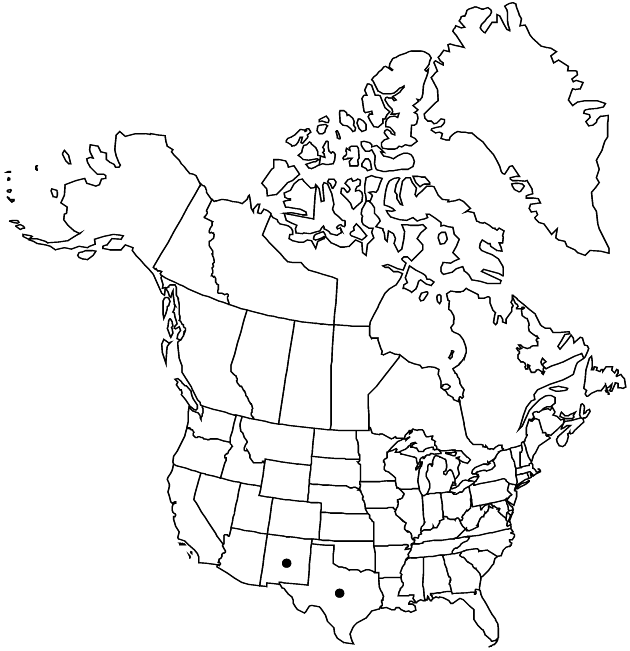Bahia pedata
Smithsonian Contr. Knowl. 3(5): 123. 1852.
Annuals or biennials, 15–70 (–120+) cm. Stems mostly erect. Leaves all or mostly alternate (proximalmost sometimes opposite); blades simple or 1–2-ternately lobed, lobes ovate or obovate to lanceolate or oblanceolate, 2–25 × 1–6 (–8) mm, faces sparsely scabrellous, usually glanddotted as well. Involucres 4–6+ × 8–12+ mm. Ray-florets 10–15; corolla laminae 5–6 (–10+) mm. Disc-florets 40–80+; corollas 3–3.5 mm. Cypselae 2.5–3.5+ mm, faces ± hirtellous; pappi of ± spatulate to oblanceolate, apically ± muticous scales 1–1.5 mm. 2n = 24.
Phenology: Flowering (May–)Jul–Aug(–Nov).
Habitat: Sandy soils, limestone, openings in grasslands and pinyon-juniper woodlands
Elevation: 900–2000 m
Distribution

N.Mex., Tex., Mexico (Chihuahua), Mexico (Coahuila)
Discussion
Selected References
None.
Lower Taxa
None.
... more about "Bahia pedata"
introrse +
connate +
herbaceous +
scarious +
absent +
hirsute +
papillate +
corymbiform +
continuous +
decurrent +
simple +
lobed +
winged;ribbed;winged;ribbed +
1;15 +
stigmatic +
6;80 +
absent +
zygomorphic +
yellow +
monomorphic +
dimorphic +
2.5mm;3.5mm +
staminate +
straight +
hirtellous +
scabrellous +
distinct +
proximal +
1;5 +
bisexual +
dispersed +
singly +
discoid +
indeterminate +
surrounding +
hemispheric +
alternate +
cauline +
2-carpellate +
inferior +
attached +
anatropous +
persistent +
fragile +
falling +
thickened +
tough +
thick +
absent +
connate +
persistent +
distinct +
falling +
unequal +
Smithsonian Contr. Knowl. +
1852 +
pistillate +
absent +
fertile +
epaleate +
pitted +
knobby;convex +
fibrous +
distinct +
muticous +
scarious +
exalbuminous +
modifed +
1;2 +
alternate +
branched +
erect +
2-branched +
papillate +
Bahia pedata +
Bahia +
species +
shorter +
longer +